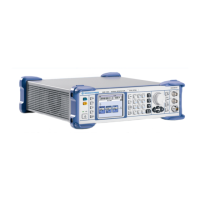Instrument Function
R&S
®
SMB100A
107Operating Manual 1407.0806.32 ─ 13
The contents list is used to open the individual help pages. It has a hierarchical struc-
ture. The highlighted line indicates where the currently displayed page is within the
contents list.
●
Index in the navigation panel
The index is used to call up all pages which contain the selected entry. The index has
an alphabetical structure and also contains all GPIB commands.
●
Find
The find function allows you to look for freely selectable terms in all help pages. A list
of the pages containing the entered term is displayed as the search result. The search
can be limited to words in the page title to increase the number of hits.
5.2.8 Storing and Loading Instrument Data - File Key
The R&S SMB allows complete instrument settings to be stored in files either on the
internal flash memory or on external USB memory devices.
Defined and complex instrument settings can then be reproduced at any time by loading
this data. If required, these settings can be loaded to various signal generators.
The corresponding menu is available under "Save/Recall" in the "Setup" menu. The
instrument settings are saved in files which can be stored in data directories.
Additionally there are intermediate memories in which the current instrument setting can
be stored and then called up again by just pressing a key. This provides fast switching
between different instrument settings.
Only settings which differ from the preset values and configuration data for the operating
elements (e.g. window positions) are stored. As a result the files remain relatively small.
Furthermore, instrument settings can easily be transferred between different equipped
signal generators since the files contain only relevant information. When loaded, the ref-
erenced settings are implemented and all non-referenced parameters are set to the
associated preset values.
If list data is part of the instrument settings, e.g. a list of user correction data, a reference
to this list is stored, not the list itself. The list is reactivated when the associated settings
are loaded, but the list may have been modified or deleted in the meantime or may not
be available on a different instrument. If the list has been modified, the new entries will
be used. An error message appears if an attempt is made to access a non-existing list
or to activate settings which are not supported by the instrument.
●
Network settings and remote settings are not saved and restored.
●
Lists are stored and loaded in the appropriate menus. For example, the user correc-
tion data list is created and stored in the "User Correction" menu.
When loading an instrument setting, it is possible to select whether the current frequency
and level setting is to be retained or whether the stored settings are to be activated. It is
possible to delete stored instrument settings. A file can be copied by loading it with
"Recall" and then storing it under a new name.
General Instrument Settings

